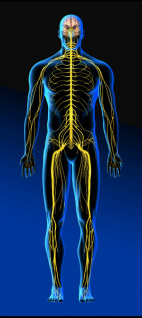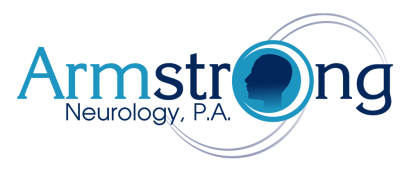Neuropathy

Neuropathy is the general term for any form of dysfunction of the peripheral nerves. Neuropathies may involve the sensory, motor, or autonomic nerves or a combination of these.
Patients with sensory neuropathy may have symptoms of numbness, tingling, burning, or lack of position sense. Motor neuropathies present with weakness. If a motor neuropathy is more progressed there may even be some wasting, or atrophy, of the muscle. Autonomic neuropathies present with symptoms such as light-headedness with standing, constipation, and urinary retention.
Many neuropathies in the United States are due to metabolic disorders such as diabetes, mild glucose intolerance, and B12 deficiency. Other common causes include systemic illnesses and genetic factors.
In fact, there are over a hundred potential causes of neuropathy. While most are due to common conditions, some neuropathies are due to rare causes. Below is a tabulation of different categories of neuropathy.
Classification of symptoms:
Fiber type
1. Predominant motor features (weakness)
2. Sensory features (numbness, tingling, burning)
3. Autonomic features (episodes of light-headedness, constipation)
Onset
1. Hyperacute
2. Acute
3. Subacute
Distribution
1. Distal
2. Proximal
3. Patchy
Hereditary features
1. Family history
Tabulation of neuropathies
1. Inherited peripheral neuropathies
I Charcot-Marie-Tooth disease type 1
II Charcot-Marie-Tooth disease type 2
III Charcot-Marie-Tooth disease type 3 (Dejerine Sottas syndrome)
IV Refsum's disease
V HMSN+hereditary spastic paraplegia
VI HMSN+hereditary optic atrophy
VII HMSN+retinitis pigmentosa
Charcot-Marie Tooth Disease
Charcot-Marie Tooth Disease 1: (all autosomal dominant except CMT1x)
a. CMT1a PMP-22 duplication 17p11.2
b. CMT1b MPZ 1q21-23
c. CMT1c LITAF 16p13.1-p12.3
d. CMT1d ERG2 10q21.1-22.1
e. CMT1e (with deafness) PMP-22 point mutation 17p11.2
f. CMT1f Neurofilament light chain 8p13-21
g. CMT1x (X-linked dominant) Connexin-32 Xq13
h. HNPP PMP22, MPZ 17p11.2, 1q21-23
LITAF - lipopolysaccharide-induced tumor necrosis factor-alpha factor
ERG2 - early growth response 2
Charcot-Marie Tooth Disease 2: (all autosomal dominant except CMT2b1)
a. CMT2a1 microtubule motor kinesin-like protein 1p36.2
b. CMT2a2 (allelic to HMSN VI with optic atrophy) MFN2 1p36.2
c. CMT2b RAB7 3q13-q22
d. CMT2b1 (autosomal recessive) Lamin A/C 1q21.2
e. CMT2b2 19q13
f. CMT2c (with vocal cord and diaphragm paralysis) 12q23-24
g. CMT2d (allelic to SMA5) Glycine tRNA synthetase 7p14
h. CMT2e (allelic to CMT1f) Neurofilament light chain 8p21
i. CMT2f Heat shock 27-kDa protein 1 7q11-q21
j. CMT2g (may be allelic to CMT4h) 12q12-q13
k. CMT2h 8q21.3
l. CMT2i (allelic to CMT1b) MPZ 1q22
m. CMT2k (allelic to CMT4a) GDAP1 8q13-q21
n. CMT2l (allelic to dHMN2) HSP8 12q24
o. CMT2x (x-linked) Xq24
MFN2 - mitofusin 2
RAB7 - small GTPase late endosomal protein
GDAP1 - ganglioside-induced differentiation-associated protein 1
Dominant intermediate CMT:
DI-CMTa 10q24.1-q25.1
DI-CMTb Dynamin-2 19p12-p13.2
DI-CMTc Tyrosyl-tRNA synthetase 1p34-p35
Charcot-Marie Tooth Disease 3: (Dejerine-Sottas disease, congenital hypomyelinating neuropathy)
PMP-22 17p11.2
Po 1q21-23
ERG2 10q21.1-22.1
Periaxon 19q13
Charcot-Marie Tooth Disease 4: (autosomal recessive)
a. CMT4a GDAP1 8q13-21.1
b. CMT4b1 MTMR2 11q23
c. CMT4b2 MTMR13 11p15
d. CMT4c SH3TC2 5q23-33
e. CMT4d (HMSN-Lom) NDRG1 8q24
f. CMT4e (congenital hypomyelinating neuropathy) PMP22, MPZ, ERG-2
g. CMT4f Periaxin 19q13.1-13.3
h. CMT4g 10q23.2
i. CMT4h Frabin 12q12-q13
GDAP1 - ganglioside-induced differentiation-associated protein 1
MTMR2 - myotubularin-related protein 2
SH3TC2 - SH3 domain tetratricopeptide repeat domain 2
NDRG1 - N-myc downstream-regulated gene
Hereditary sensory neuropathies
a. HSN I (Hereditary sensory neuropathy of Denny-Brown)
b. HSN II (Morvan’s syndrome, Infantile syringomyelia, Congenital sensory neuropathy)
c. HSN III (Riley-Day syndrome, Familial dysautonomia)
d. HSN IV (Congenital sensory neuropathy with loss of sweating)
2. Metabolic neuropathies (biochemical defect identified)
1. Amyloid neuropathy
2. Lipoprotein disorders and peripheral neuropathy
a. Cerebral lipoidoses
b. Metachromatic leukodystrophies - arylsulfatase A
c. Krabbe’s disease - galactocerebrosidase
d. Neuropathy due to glycoprotein deficiency
e. Bassen-Kornzweig syndrome (A-betalipoproteinemia)
f. Tangier disease (High-density lipoprotein deficiency)
g. Refsum’s disease (Hereditary ataxic neuropathy, phytanic acid storage disease)
h. Fabry’s disease (Angiokeratoma corporis diffusum, a-galactosidase A deficiency)
3. Infectious neuropathies
1. Leprosy (Hansen’s disease)
2. Herpes Zoster
3. Diphtheritic neuropathy
4. Sarcoidosis
4. Toxic neuropathies
1. Arsenic
2. B6 - a sensory neuronopathy with impaired large fiber sensory modalities (ataxia, vibration)
3. Dapsone - distal, primarily motor neuropathy
4. Colchicine - neuromyopathy with distal sensory loss and weakness.
5. Lead
6. Tacrolimus - a demyelinating neuropathy with prominent weakness
7. Thallium
8. Tri-ortho-cresyl phosphate
9. Organic solvents in glue
10. Zidovudine - myopathy
5. Drug-induced neuropathies
Dapsone: Motor more than sensory neuropathy
HIV medications (Didanosin, stavudine, zalcitabine): may cause a sensory neuropathy.
Isoniazid and ethambutol: sensorimotor neuropathy.
Vinca alkaloids: motor more than sensory neuropathy
6. Neuropathy secondary to underlying medical conditions
1. Diabetic neuropathy
2. Neuropathy due to paraproteinemias
3. Acute intermittent porphyria
4. Ischemic neuropathy
5. Neuropathy of chronic renal failure
6. Neuropathy with malignant disease
7. Lymphoma-associated neuropathy
7. Motor neuropathies
1. Guillain-Barre syndrome
2. CIDP (AMAN variant)
3. Porphyria
4. Multifocal motor neuropathy
5. Diphtheria
6. Lead intoxication
7. Botulism
8. Hereditary motor neuropathies
9. Toxins: Dapsone, Amiodarone, Vincristine, Arsenic, gold, perhexilene
8. Sensory neuropathies often with autonomic dysfunction
1. Acute idiopathic sensory neuropathy
2. Amyloidosis
3. Carcinoma
4. Diabetes mellitus
5. Inherited sensory neuropathies
6. Lepromatous leprosy
7. Primary biliary cirrhosis
8. Thallium poisoning
9. Sensory neuropathy without autonomic dysfunction
1. Diabetes
2. B12 deficiency, E, thiamine
3. HIV
4. Amyloidosis
5. Leprosy
6. Sjorgrens syndrome
7. Sarcoidosis
8. Uremia
9. Paraneoplastic disorders
10. Vitamin B6 intoxication
11. Hereditary sensory neuropathies
12. Vasculitis
10. Various acquired neuropathies
1 Acromegaly
2 Acute idiopathic sensory and pandysautonomic neuropathies
3 Alcoholism (an axonal neuropathy with secondary demyelination)
4 Brachial neuropathy
5 Chronic demyelinating polyneuropathy
6 Diabetes mellitus
7 Diphtheria
8 Guillain-Barré syndrome
9 Hypothyroidism
10 Malignancies
11 Nerve entrapments
12 Neurotoxins
13 Sarcoidosis
14 Tick paralysis
15 Uremia
16 Vasculitic disorders
11. Immunological-Paraproteinemic neuropathies
1. Gangliosides:
a. GM1 (Multifocal motor neuropathy, GBS)
b. GQ1b (Miller-Fisher syndrome, GBS variants; GBS with ophthalmoplegia, pharyngeal-cervical-brachial variant)
c. GT1a (Pharyngeal-cervical-brachial variant of GBS)
d. GD1b (CANOMAD: chronic ataxic neuropathy with ophthalmoplegia)
2. Glycoproteins / glycolipids:
a. MAG (DADs-M: distal acquired demyelinating symmetric neuropathy variant of CIDP with monoclonal M-protein)
b. Sulfatide (sensory-predominant neuropathy, axonal or demyelinating)
3. Paraneoplastic conditions:
a. Hu (sensory neuronopathy, limbic / brainstem encephalitis, cerebellar degeneration)
b. CV2 (mixed axonal demyelinating sensorimotor neuropathy, cerebellar degeneration, uveitis, optic neuritis)
c. VGKC (acquired neuromyotonia, Morvan syndrome)
4. Vasculitis:
a. c-ANCA (Wegener granulomatosis > microscopic polyangitis, Churg-Strauss
b. p-ANCA (microscopic polyangitis > Wegener granulomatosis, Churg-Strauss
c. RNP; Ro (SS-A), La (SS-B) (Sjogren syndrome)
d. ANA, dsDNA, SM (SLE)
e. Scl-70 (Scleroderma)
f. Centromere (CREST: calcinosis, Raynaud phenomenon, esophageal dysmotility, sclerodactyly, telangiectasia)
g. U1-RNP (mixed connective tissue disease)
h. RF, CCP (rheumatoid arthritis > other connective tissue disorders
ANA - antinuclear antibodies
ANCA - anti-neutrophil cytoplasmic antibodies
CCP - cyclic citrullinated peptides
RNP - ribonucleoprotein
Other immunological conditions:
5. Amyloidosis
6. Anti-MAG, SGPG (IgM-κ)
7. Cyroglobulinemia
8. Hepatitis C (IgM-κ)
9. Lymphoma
10. Monoclonal gammopathy of undetermined significance (MGUS)
11. Multiple myeloma
12. Osteosclerotic myeloma and POEMS (IgG or IgA, almost always λ)
13. Waldenstrom’s Macroglobulinemia (IgM)
12. Asymmetric, multifocal sensory and motor neuropathies
1. Vasculitis
2. Multifocal CIDP (MADSAM)
3. Neoplastic
4. Diabetic
5. Leprosy
6. HNPP
7. Lyme disease
8. HIV-associated CMV multiple mononeuropathy
9. Sarcoidosis
10. Amyloidosis
11. Acute brachial neuritis (Parsonage-Turner syndrome)
13. Timing of onset
Hyperacute
- Vasculitis
Acute
- GBS
- Vasculitis
- Porphyria - a motor neuropathy
- Infectious (Lyme, Diptheria (sensory)
- Toxic / Drug (Arsenic, thallium, chemotherapy, dapsone)
Subacute
- Toxic
- Nutritional
- Malignancy
- Paraneoplastic
14. Trigeminal Sensory Neuropathy
Connective tissue disorders: Sjögren syndrome, MCTD, Scleroderma
Leprosy
Sarcoidosis
Tumor
Lyme disease
Toxic: trichloroethylene / dicholoracetylene
Multiple sclerosis
15. Atypical neuropathies
Tangier disease: syringomyelia-like presentation
FOSMN: facial-onset sensory and motor neuropathy (variatn of CIDP - anti-GT1a)
Porphyric neuropathy: proximal weakness
Non-length dependent small-fiber ganglionopathy
Leprosy: patchy sensory loss
Mental nerve neuropathy (numb chin syndrome, Roger's sign): carcinoma, lymphoma, dental procedure
16. Neuromyopathies
Uremia
Sarcoidosis
Amyloidosis
Paraneoplastic
Connective tissue disorders
Acromegaly
HIV
HTLV1
Lyme disease
Critical illness myopathy and neuropathy
Mitochondrial disorders
Inclusion body myopathy
Adult polyglucosan body disease
Toxic: Colchicine, chloroquine, hydroxychloroquine, amiodarone, ethanol, L-tryptophan, vincristine
17. Polyneuropathy with Optic Neuropathy
B12 deficiency
Copper deficiency
Thiamine deficiency
Tobacco-alcohol amblyopia
Cuban epidemic (nutritional multiple vitamin deficiencies)
Cassava toxicity (cyanide)
Hereditary: CMT2A, HMSN VI, Leber hereditary optic neuropathy
Toxic: amiodarone, chloramphenicol, chloroquine, disulfiram, ethambutol, isoniazid, linezolid, penicillamine, vincristine
18. Peripheral neuropathy with dysautonomia
Immune:
Paraneoplastic
Guillain-Barre
Infiltrative:
Amyloidosis
Metabolic:
Porphyria
Diabetes
Toxic:
cis-Platinum
Vinca alkaloids
Perihexilene
Hexacarobons
Thallium
Arsenic
Acrylamide
Taxol
Lead
Pesticides
Pyridoxine toxicity
Hereditary:
Familial amyloidosis
HSAN
Fabrys disease
Tangiers disease
Mitochondrial disorders
I Charcot-Marie-Tooth disease type 1
II Charcot-Marie-Tooth disease type 2
III Charcot-Marie-Tooth disease type 3 (Dejerine Sottas syndrome)
IV Refsum's disease
V HMSN+hereditary spastic paraplegia
VI HMSN+hereditary optic atrophy
VII HMSN+retinitis pigmentosa
Charcot-Marie Tooth Disease
Charcot-Marie Tooth Disease 1: (all autosomal dominant except CMT1x)
a. CMT1a PMP-22 duplication 17p11.2
b. CMT1b MPZ 1q21-23
c. CMT1c LITAF 16p13.1-p12.3
d. CMT1d ERG2 10q21.1-22.1
e. CMT1e (with deafness) PMP-22 point mutation 17p11.2
f. CMT1f Neurofilament light chain 8p13-21
g. CMT1x (X-linked dominant) Connexin-32 Xq13
h. HNPP PMP22, MPZ 17p11.2, 1q21-23
LITAF - lipopolysaccharide-induced tumor necrosis factor-alpha factor
ERG2 - early growth response 2
Charcot-Marie Tooth Disease 2: (all autosomal dominant except CMT2b1)
a. CMT2a1 microtubule motor kinesin-like protein 1p36.2
b. CMT2a2 (allelic to HMSN VI with optic atrophy) MFN2 1p36.2
c. CMT2b RAB7 3q13-q22
d. CMT2b1 (autosomal recessive) Lamin A/C 1q21.2
e. CMT2b2 19q13
f. CMT2c (with vocal cord and diaphragm paralysis) 12q23-24
g. CMT2d (allelic to SMA5) Glycine tRNA synthetase 7p14
h. CMT2e (allelic to CMT1f) Neurofilament light chain 8p21
i. CMT2f Heat shock 27-kDa protein 1 7q11-q21
j. CMT2g (may be allelic to CMT4h) 12q12-q13
k. CMT2h 8q21.3
l. CMT2i (allelic to CMT1b) MPZ 1q22
m. CMT2k (allelic to CMT4a) GDAP1 8q13-q21
n. CMT2l (allelic to dHMN2) HSP8 12q24
o. CMT2x (x-linked) Xq24
MFN2 - mitofusin 2
RAB7 - small GTPase late endosomal protein
GDAP1 - ganglioside-induced differentiation-associated protein 1
Dominant intermediate CMT:
DI-CMTa 10q24.1-q25.1
DI-CMTb Dynamin-2 19p12-p13.2
DI-CMTc Tyrosyl-tRNA synthetase 1p34-p35
Charcot-Marie Tooth Disease 3: (Dejerine-Sottas disease, congenital hypomyelinating neuropathy)
PMP-22 17p11.2
Po 1q21-23
ERG2 10q21.1-22.1
Periaxon 19q13
Charcot-Marie Tooth Disease 4: (autosomal recessive)
a. CMT4a GDAP1 8q13-21.1
b. CMT4b1 MTMR2 11q23
c. CMT4b2 MTMR13 11p15
d. CMT4c SH3TC2 5q23-33
e. CMT4d (HMSN-Lom) NDRG1 8q24
f. CMT4e (congenital hypomyelinating neuropathy) PMP22, MPZ, ERG-2
g. CMT4f Periaxin 19q13.1-13.3
h. CMT4g 10q23.2
i. CMT4h Frabin 12q12-q13
GDAP1 - ganglioside-induced differentiation-associated protein 1
MTMR2 - myotubularin-related protein 2
SH3TC2 - SH3 domain tetratricopeptide repeat domain 2
NDRG1 - N-myc downstream-regulated gene
Hereditary sensory neuropathies
a. HSN I (Hereditary sensory neuropathy of Denny-Brown)
b. HSN II (Morvan’s syndrome, Infantile syringomyelia, Congenital sensory neuropathy)
c. HSN III (Riley-Day syndrome, Familial dysautonomia)
d. HSN IV (Congenital sensory neuropathy with loss of sweating)
2. Metabolic neuropathies (biochemical defect identified)
1. Amyloid neuropathy
2. Lipoprotein disorders and peripheral neuropathy
a. Cerebral lipoidoses
b. Metachromatic leukodystrophies - arylsulfatase A
c. Krabbe’s disease - galactocerebrosidase
d. Neuropathy due to glycoprotein deficiency
e. Bassen-Kornzweig syndrome (A-betalipoproteinemia)
f. Tangier disease (High-density lipoprotein deficiency)
g. Refsum’s disease (Hereditary ataxic neuropathy, phytanic acid storage disease)
h. Fabry’s disease (Angiokeratoma corporis diffusum, a-galactosidase A deficiency)
3. Infectious neuropathies
1. Leprosy (Hansen’s disease)
2. Herpes Zoster
3. Diphtheritic neuropathy
4. Sarcoidosis
4. Toxic neuropathies
1. Arsenic
2. B6 - a sensory neuronopathy with impaired large fiber sensory modalities (ataxia, vibration)
3. Dapsone - distal, primarily motor neuropathy
4. Colchicine - neuromyopathy with distal sensory loss and weakness.
5. Lead
6. Tacrolimus - a demyelinating neuropathy with prominent weakness
7. Thallium
8. Tri-ortho-cresyl phosphate
9. Organic solvents in glue
10. Zidovudine - myopathy
5. Drug-induced neuropathies
Dapsone: Motor more than sensory neuropathy
HIV medications (Didanosin, stavudine, zalcitabine): may cause a sensory neuropathy.
Isoniazid and ethambutol: sensorimotor neuropathy.
Vinca alkaloids: motor more than sensory neuropathy
6. Neuropathy secondary to underlying medical conditions
1. Diabetic neuropathy
2. Neuropathy due to paraproteinemias
3. Acute intermittent porphyria
4. Ischemic neuropathy
5. Neuropathy of chronic renal failure
6. Neuropathy with malignant disease
7. Lymphoma-associated neuropathy
7. Motor neuropathies
1. Guillain-Barre syndrome
2. CIDP (AMAN variant)
3. Porphyria
4. Multifocal motor neuropathy
5. Diphtheria
6. Lead intoxication
7. Botulism
8. Hereditary motor neuropathies
9. Toxins: Dapsone, Amiodarone, Vincristine, Arsenic, gold, perhexilene
8. Sensory neuropathies often with autonomic dysfunction
1. Acute idiopathic sensory neuropathy
2. Amyloidosis
3. Carcinoma
4. Diabetes mellitus
5. Inherited sensory neuropathies
6. Lepromatous leprosy
7. Primary biliary cirrhosis
8. Thallium poisoning
9. Sensory neuropathy without autonomic dysfunction
1. Diabetes
2. B12 deficiency, E, thiamine
3. HIV
4. Amyloidosis
5. Leprosy
6. Sjorgrens syndrome
7. Sarcoidosis
8. Uremia
9. Paraneoplastic disorders
10. Vitamin B6 intoxication
11. Hereditary sensory neuropathies
12. Vasculitis
10. Various acquired neuropathies
1 Acromegaly
2 Acute idiopathic sensory and pandysautonomic neuropathies
3 Alcoholism (an axonal neuropathy with secondary demyelination)
4 Brachial neuropathy
5 Chronic demyelinating polyneuropathy
6 Diabetes mellitus
7 Diphtheria
8 Guillain-Barré syndrome
9 Hypothyroidism
10 Malignancies
11 Nerve entrapments
12 Neurotoxins
13 Sarcoidosis
14 Tick paralysis
15 Uremia
16 Vasculitic disorders
11. Immunological-Paraproteinemic neuropathies
1. Gangliosides:
a. GM1 (Multifocal motor neuropathy, GBS)
b. GQ1b (Miller-Fisher syndrome, GBS variants; GBS with ophthalmoplegia, pharyngeal-cervical-brachial variant)
c. GT1a (Pharyngeal-cervical-brachial variant of GBS)
d. GD1b (CANOMAD: chronic ataxic neuropathy with ophthalmoplegia)
2. Glycoproteins / glycolipids:
a. MAG (DADs-M: distal acquired demyelinating symmetric neuropathy variant of CIDP with monoclonal M-protein)
b. Sulfatide (sensory-predominant neuropathy, axonal or demyelinating)
3. Paraneoplastic conditions:
a. Hu (sensory neuronopathy, limbic / brainstem encephalitis, cerebellar degeneration)
b. CV2 (mixed axonal demyelinating sensorimotor neuropathy, cerebellar degeneration, uveitis, optic neuritis)
c. VGKC (acquired neuromyotonia, Morvan syndrome)
4. Vasculitis:
a. c-ANCA (Wegener granulomatosis > microscopic polyangitis, Churg-Strauss
b. p-ANCA (microscopic polyangitis > Wegener granulomatosis, Churg-Strauss
c. RNP; Ro (SS-A), La (SS-B) (Sjogren syndrome)
d. ANA, dsDNA, SM (SLE)
e. Scl-70 (Scleroderma)
f. Centromere (CREST: calcinosis, Raynaud phenomenon, esophageal dysmotility, sclerodactyly, telangiectasia)
g. U1-RNP (mixed connective tissue disease)
h. RF, CCP (rheumatoid arthritis > other connective tissue disorders
ANA - antinuclear antibodies
ANCA - anti-neutrophil cytoplasmic antibodies
CCP - cyclic citrullinated peptides
RNP - ribonucleoprotein
Other immunological conditions:
5. Amyloidosis
6. Anti-MAG, SGPG (IgM-κ)
7. Cyroglobulinemia
8. Hepatitis C (IgM-κ)
9. Lymphoma
10. Monoclonal gammopathy of undetermined significance (MGUS)
11. Multiple myeloma
12. Osteosclerotic myeloma and POEMS (IgG or IgA, almost always λ)
13. Waldenstrom’s Macroglobulinemia (IgM)
12. Asymmetric, multifocal sensory and motor neuropathies
1. Vasculitis
2. Multifocal CIDP (MADSAM)
3. Neoplastic
4. Diabetic
5. Leprosy
6. HNPP
7. Lyme disease
8. HIV-associated CMV multiple mononeuropathy
9. Sarcoidosis
10. Amyloidosis
11. Acute brachial neuritis (Parsonage-Turner syndrome)
13. Timing of onset
Hyperacute
- Vasculitis
Acute
- GBS
- Vasculitis
- Porphyria - a motor neuropathy
- Infectious (Lyme, Diptheria (sensory)
- Toxic / Drug (Arsenic, thallium, chemotherapy, dapsone)
Subacute
- Toxic
- Nutritional
- Malignancy
- Paraneoplastic
14. Trigeminal Sensory Neuropathy
Connective tissue disorders: Sjögren syndrome, MCTD, Scleroderma
Leprosy
Sarcoidosis
Tumor
Lyme disease
Toxic: trichloroethylene / dicholoracetylene
Multiple sclerosis
15. Atypical neuropathies
Tangier disease: syringomyelia-like presentation
FOSMN: facial-onset sensory and motor neuropathy (variatn of CIDP - anti-GT1a)
Porphyric neuropathy: proximal weakness
Non-length dependent small-fiber ganglionopathy
Leprosy: patchy sensory loss
Mental nerve neuropathy (numb chin syndrome, Roger's sign): carcinoma, lymphoma, dental procedure
16. Neuromyopathies
Uremia
Sarcoidosis
Amyloidosis
Paraneoplastic
Connective tissue disorders
Acromegaly
HIV
HTLV1
Lyme disease
Critical illness myopathy and neuropathy
Mitochondrial disorders
Inclusion body myopathy
Adult polyglucosan body disease
Toxic: Colchicine, chloroquine, hydroxychloroquine, amiodarone, ethanol, L-tryptophan, vincristine
17. Polyneuropathy with Optic Neuropathy
B12 deficiency
Copper deficiency
Thiamine deficiency
Tobacco-alcohol amblyopia
Cuban epidemic (nutritional multiple vitamin deficiencies)
Cassava toxicity (cyanide)
Hereditary: CMT2A, HMSN VI, Leber hereditary optic neuropathy
Toxic: amiodarone, chloramphenicol, chloroquine, disulfiram, ethambutol, isoniazid, linezolid, penicillamine, vincristine
18. Peripheral neuropathy with dysautonomia
Immune:
Paraneoplastic
Guillain-Barre
Infiltrative:
Amyloidosis
Metabolic:
Porphyria
Diabetes
Toxic:
cis-Platinum
Vinca alkaloids
Perihexilene
Hexacarobons
Thallium
Arsenic
Acrylamide
Taxol
Lead
Pesticides
Pyridoxine toxicity
Hereditary:
Familial amyloidosis
HSAN
Fabrys disease
Tangiers disease
Mitochondrial disorders
Diagnosis:
Your neurologist can determine the cause of neuropathy in most cases. Common diagnostic studies include laboratory studies and nerve conduction studies. The nerve conduction study is a simple test that can be performed in the neurologist's office. Occasionally more specific testing can be performed if indicated. Once the cause, or etiology, of the neuropathy is known, appropriate treatment can be planned. In the vast majority of cases patients experience improvement in their symptoms.

